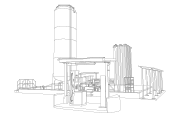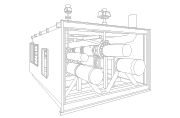Natural gas processing is one of the essential procedures enabling the use of natural gas as energy today.
Today, natural gas represents around 25% of the world’s energy generation, according to the International Energy Agency (IEA). As such, natural gas processing constitutes an essential piece in the puzzle that promotes this adoption at a global level.
In this context, we share a complete guide on natural gas processing and the specific equipment and systems involved in a plant dedicated to this operation.
Natural gas: what is it?
Natural gas is a mixture of hydrocarbon gasses. Formed from the decomposition of organic matter under high pressure and temperature over millions of years, it is found in underground deposits and functions as a source of fossil energy.
Composition and characteristics of natural gas
Methane (CH₄) is the main component of natural gas (between 70-90%). In smaller quantities, the composition of natural gas also includes ethane (C₂H₆), propane (C₃H₈) and butane (C₄H₁₀), which, are separated in the gas processing plant and sold separately as liquefied petroleum gasses (LPG).
In addition, the composition of natural gas may also contain small amounts of other hydrocarbons (such as pentane), carbon dioxide (CO₂), nitrogen (N₂), hydrogen (H₂), and traces of helium (He) and sulfides (such as sulfur of hydrogen, H₂S).
The characteristics of natural gas include being colorless and odorless in its natural form, as well as being lighter than air. It is also considered an efficient and more sustainable source of energy than other fossil fuels, since its combustion produces less carbon dioxide and pollutants.
How is natural gas extracted?
Natural gas is extracted from underground reservoirs through drilling wells into the geological formations where it is trapped.
Once a well reaches the gas reservoir, the natural pressure within the reservoir allows the gas to flow up the well to the surface, where natural gas processing through a gas plant can take place.
How does natural gas get processed?
Simply put, natural gas processing refers to the industrial separation processes aimed at eliminating impurities in extracted natural gas. The resulting substance is dry gas (mainly composed of methane) that is suitable for transportation and consumption.
As such, after natural gas extraction, a series of operations are required to separate the useful components and, at the same time, eliminate substances such as oil, sulfur, carbon dioxide and water. In addition, the processing of natural gas also allows the separation of natural gas liquids (NGLs or condensates) that are further processed and used independently.
A look at the main stages of natural gas processing reveals the following steps:
1. Separation of liquids and solids
An initial physical separation is performed to remove solids and heavier liquids often present in extracted natural gas (such as oil, water, sand…).
2. Dehydration
The substance obtained in the previous step is subjected to a process to eliminate water through dehydrators. Glycol absorption units or molecular sieve adsorption can be used at this stage.
The goal is to eliminate water vapor to prevent hydrate formation and, consequently, pipeline corrosion.
3. Removal of acid gasses
The next step involves removing CO₂ and H₂S to prevent pipeline corrosion and meet gas quality standards. Various techniques, including amine absorption, may be employed.
Some plants also include sulfur compound removal if deemed necessary.
4. Eliminating mercury and nitrogen
If required, the gas passes through activated carbon beds or specific molecular sieves to remove traces of mercury, which can be harmful.
Additionally, if the gas has high nitrogen content, cryogenic distillation or adsorption processes are used to reduce its presence.
This operation enhances the calorific value of natural gas and reduces its volume, crucial for transportation.
5. Recovery of Natural Gas Liquids (NGLs)
In this step, the obtained gas is cooled and compressed to separate natural gas liquids (NGLs) or condensates.
These substances must undergo a fractionation process for further utilization.
6. Cryogenic processing
The gas is cooled to very low (cryogenic) temperatures using cryogenic heat exchangers and turboexpanders capable of liquefying and separating heavy components.
7. Compression, storage and transportation
Dry natural gas is compressed at high pressures for transportation. It may be stored underground or in cryogenic tanks if converted to liquefied natural gas (LNG).
It might also be of your interest: A flat-bottom tank that defies earthquakes: one more success story for Cryospain
Why is natural gas processing important?
Through the steps we have just described, natural gas processing essentially enables four actions:
- Elimination of impurities and potentially harmful elements (carbon dioxide, water, hydrogen sulfide…).
- Separation of non-combustible components (e.g., nitrogen), which do not contribute to heat during combustion and reduce the calorific value of natural gas.
- Recovery of natural gas liquids (NGLs) for separate commercialization.
- Adjustment of gas pressure to meet requirements for transportation and storage.
Together, the steps in natural gas processing have proven indispensable in promoting the global use of natural gas as an energy source.
These processes are crucial to ensure the substance is efficient and entirely safe throughout its cycle and all subsequent activities (fractionation, transportation, natural gas liquefaction plants, regasification plants…).
Processing enhances its quality and calorific value, reduces corrosion issues or potential accidents, and helps mitigate greenhouse gas emissions and other pollutants, in compliance with environmental regulations.
Moreover, extracting the natural gas liquids or condensates adds additional economic value due to their high commercial worth.
Technical needs in natural gas processing
Equipment
- Separators: essential in the initial phase, they allow the separation of natural gas from associated liquids. They are based on gravitational or centrifugation methods to separate each component.
- Slug catchers: responsible for separating accumulated liquids from the flow of gas or oil, they allow the gas to continue flowing evenly.
- Dehydrators: in charge of removing moisture from natural gas using drying agents such as glycols or molecular sieves.
- Absorption towers: this infrastructure allows the application of various techniques to separate specific components. An example is amine absorption towers, used to remove acidic gasses like carbon dioxide (CO₂) and hydrogen sulfide (H₂S) from natural gas.
- Compressors: equipment capable of increasing gas pressure, reducing its volume, and increasing its energy density, essential for transportation.
- Heat exchangers: responsible for cooling the gas and condensing natural gas liquids (NGLs).
- Turboexpanders: in charge of expanding gas at high pressure through a turbine. This causes a significant decrease in the temperature of natural gas, crucial for separating components that condense at lower temperatures.
For more information: Tailor-made equipment
Plants
Natural gas processing plants are the epicenter of all the processes we have described, making natural gas suitable for use from the moment it is received.
Designed to perform processes with maximum efficiency (including the best practices in natural gas plant maintenance), they must balance the quality and safety requirements of the supplied natural gas with other needs such as maximizing economic value and facilitating the transportation and storage of natural gas.
In this regard, they are indispensable allies for subsequent facilities, such as natural gas cryogenic plants (which liquefy natural gas for efficient transportation and storage) and regasification plants (which return liquefied natural gas to its gaseous state for use).
Pipes
Pipelines are the transportation pipes responsible for transporting large volumes of natural gas: on one hand, from production fields to processing plants; on the other hand, from plants to consumption points.
In 2023, there were 1,869 operational pipelines worldwide, with China presenting the highest number, according to figures published by Statista. It is worth mentioning here that the ability to transport liquefied natural gas via cryogenic tanks has increased the available options for transporting this gas and, consequently, its reach.
Beyond these pipelines, gas processing plants feature other types of pipes dedicated to facilitating all the stages we have described. These include pipelines used for:
- Interconnection and distribution
- Vacuum-insulated pipelines
- Water and liquid recycling
- Waste and emissions disposal
- Natural Gas Liquids exportation
All of these are subject to specific regulations and standards and must undergo regular inspections and preventive maintenance.
Cryospain: Experts in the development of natural gas processing plants
Building from our decades-long experience in cryogenic engineering and gas processing, at Cryospain we generate tailor-made projects for natural gas processing plants.
We create efficient and highly secure infrastructures through a comprehensive process that includes the following phases:
- Preliminary analysis of project needs by our engineering team, taking into account client requirements.
- Project design and 2D and 3D prototypes based on the highest standards of quality and safety. These prototypes outline necessary equipment and accessories, plant design, and safety analysis, among other key elements.
- Implementation of the processing plant according to design specifications.
- Design and implementation of maintenance protocols, ensuring the plant operates safely and efficiently at all times.
Would you like to learn more about our work and how we can develop your natural gas processing project? Get in touch with our team to discuss how we can help you.









